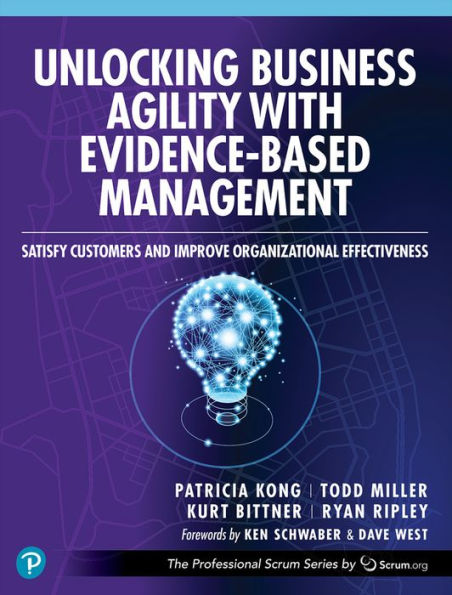Organizations often believe in the certainty of their plans and see every deviation from the plan as a sign of failure. They view the organization as a machine for creating and executing plans instead of looking at it as a responsive organism, attentive to the changes in its environment. In a world of uncertainties, organizations need to be capable of reinventing themselves every day based on new information.
In Unlocking Business Agility with Evidence-Based Management, authors Patricia Kong, Todd Miller, Kurt Bittner, and Ryan Ripley use the framework developed by Scrum.org called Evidence-Based Management (EBM). EBM is an empirical approach that helps organizations use experimentation and rapid feedback to progress toward goals. This path is not always obvious or straightforward, but that is a benefit: in a complex and changing world, the path toward goals will always be uncertain. EBM helps organizations use new data to adapt their plan toward their goals.
Throughout the book, the authors present stories and experiences that illustrate how EBM can be applied to set better goals and then leverage empiricism to achieve those goals using feedback, learning, and evidence. This definitive guide will help your organization identify its true purpose, improve its ability to reach goals, and build a culture of trust, transparency, and growth.
- Clarify goals and demonstrate value, success, and progress using agile metrics
- Progress toward goals in uncertain and rapidly changing circumstances
- Embrace empiricism and experimentation to find solutions for complex problems
- Find real-world anonymized case studies on how to articulate goals and measurements in a way that fosters self-management and business agility
Register your book for convenient access to downloads, updates, and/or corrections as they become available. See inside book for details.
Organizations often believe in the certainty of their plans and see every deviation from the plan as a sign of failure. They view the organization as a machine for creating and executing plans instead of looking at it as a responsive organism, attentive to the changes in its environment. In a world of uncertainties, organizations need to be capable of reinventing themselves every day based on new information.
In Unlocking Business Agility with Evidence-Based Management, authors Patricia Kong, Todd Miller, Kurt Bittner, and Ryan Ripley use the framework developed by Scrum.org called Evidence-Based Management (EBM). EBM is an empirical approach that helps organizations use experimentation and rapid feedback to progress toward goals. This path is not always obvious or straightforward, but that is a benefit: in a complex and changing world, the path toward goals will always be uncertain. EBM helps organizations use new data to adapt their plan toward their goals.
Throughout the book, the authors present stories and experiences that illustrate how EBM can be applied to set better goals and then leverage empiricism to achieve those goals using feedback, learning, and evidence. This definitive guide will help your organization identify its true purpose, improve its ability to reach goals, and build a culture of trust, transparency, and growth.
- Clarify goals and demonstrate value, success, and progress using agile metrics
- Progress toward goals in uncertain and rapidly changing circumstances
- Embrace empiricism and experimentation to find solutions for complex problems
- Find real-world anonymized case studies on how to articulate goals and measurements in a way that fosters self-management and business agility
Register your book for convenient access to downloads, updates, and/or corrections as they become available. See inside book for details.

Unlocking Business Agility with Evidence-Based Management: Satisfy Customers and Improve Organizational Effectiveness
224
Unlocking Business Agility with Evidence-Based Management: Satisfy Customers and Improve Organizational Effectiveness
224
Product Details
| ISBN-13: | 9780138244576 |
|---|---|
| Publisher: | Pearson Education |
| Publication date: | 10/31/2023 |
| Series: | The Professional Scrum Series |
| Pages: | 224 |
| Product dimensions: | 6.95(w) x 9.10(h) x 0.54(d) |
